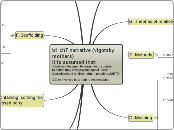jonka Joerg Bauer 15 vuotta sitten
445
b1 ch7 narrative

jonka Joerg Bauer 15 vuotta sitten
445

Lisää tämän kaltaisia
Othe culture are very different
Papua New Guinea
rarely talk or make eye contact
baby seen as unable to undersatnd
Paradox of familarity
Interaction looks familar but the underlying meaning might be unclear
child experieces good breast and bad breast
1. depressive position=
But:Stern: Babies are unable to divide experiences. Normal experiences are good enought to get notion of grades of goodness
Realization of one object: giving up the complete good leads to ambivalence
Leading to good satisfying relationships
Unablie to unify =
copying with bad experience
2. schizoid position
catching their attention by certain movment contingent on their looking - assisting with her own.
Book reading action format
Book reading using 4 utterances
rules of polite adult dialogue
contingent on childs behaviour
structure which allows better transmition (adult controlled)
simple stereotyped sequences of actions w. objects
Joint attention
creates awareness of each others state (to subjective experience of the other)
Mother frame infants behaviour so that they can become more active
pseudo-dialogue might have no meaning but it is interactive
Mothers adust their speach w. high pitch,short, exagerated
thought to facilitate learning
Dev. of greeting: + clustering vs. random, passive to equal participation
26w equally reative and proactve: most likely when infant was attending to mother
13w some proative
clustering i.e. like burst pause rhythm
6w random and reactive
Produces a Conversation-like interaction
Burst pause feedin: mothers fit behaviour around their shaking and talking
mother gives meaning to babies beh. and babies respond (s still face)
Babies: Even very young babies are active particpants: Brazelton&Cramer
Mothers: i.e. scaffolding: How mothers shape their behaviour around the child
Research based on minimizing emotions
good or bad but bad emotions challenge self image of mother
However puts too much emphasis on mother. infant interactions
Shaped by western construction of how relation has to be.
important concept for how wee see other people (dealing conciously not acceptable desires, fears etc.)
Our own mental representatinos are partially shaped by our whishful thinking
Child
Projecst own motives into caregiver
Carer
Projects own motives into child
attributions will shape careres behaviour
vs. Freud important from birth
subjective interpretation of psychoanlyst is important
Early relationships important for adult personality (3-5y)
oedipus complex start of devlopment towars male or female identity
Cohn: Still face studies show that babies protest and react wari when showed depressse expresssions
Traverthen: in the first month babies and moms interations are fine-tuned & coordinated